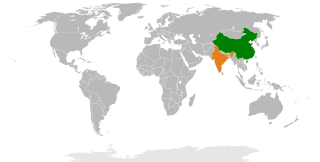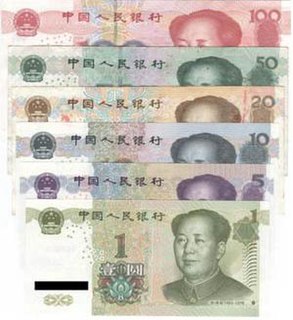
Asia is Earth's largest and most populous continent, located primarily in the Eastern and Northern Hemispheres. It shares the continental landmass of Eurasia with the continent of Europe and the continental landmass of Afro-Eurasia with both Europe and Africa. Asia covers an area of 44,579,000 square kilometres (17,212,000 sq mi), about 30% of Earth's total land area and 8.7% of the Earth's total surface area. The continent, which has long been home to the majority of the human population, was the site of many of the first civilizations. Asia is notable for not only its overall large size and population, but also dense and large settlements, as well as vast barely populated regions. Its 4.5 billion people constitute roughly 60% of the world's population.

China, officially the People's Republic of China, is a country in East Asia. It is the world's most populous country, with a population of around 1.4 billion in 2019. Covering approximately 9.6 million square kilometres, it is the world's third or fourth largest country by area. Governed by the Communist Party of China, the state exercises jurisdiction over 22 provinces, five autonomous regions, four direct-controlled municipalities, and the special administrative regions of Hong Kong and Macau.

Chiang Kai-shek , also known as Chiang Chung-cheng and romanized via Mandarin as Chiang Chieh-shih and Jiang Jieshi, was a Chinese nationalist politician, revolutionary and military leader who served as the leader of the Republic of China between 1928 and 1975, first in mainland China until 1949 and then in Taiwan until his death.

Hong Kong, officially the Hong Kong Special Administrative Region of the People's Republic of China (HKSAR), is a metropolitan area and special administrative region of the People's Republic of China in the eastern Pearl River Delta by the South China Sea. With over 7.5 million people of various nationalities, in a 1,104-square-kilometre (426 sq mi) territory, Hong Kong is one of the most densely populated places in the world.

Li Lianjie, better known by his stage name Jet Li, is a Chinese film actor, film producer, martial artist, and retired Wushu champion who was born in Beijing. He is a naturalized Singaporean citizen.

The Korean War was a war between North Korea and South Korea. The war began on 25 June 1950 when North Korea invaded South Korea.

The Kuomintang, often referred to in English as the Nationalist Party or Chinese Nationalist Party (CNP), is a major political party in Taiwan, i.e. the Republic of China, based in Taipei. Formed in 1919, the KMT was the sole ruling party of the Republic of China from 1928 to 2000 and is currently an opposition political party in the Legislative Yuan.

Taiwan, officially the Republic of China (ROC), is a country in East Asia. Neighbouring countries include the People's Republic of China (PRC) to the north-west, Japan to the north-east, and the Philippines to the south. The island of Taiwan has an area of 35,808 square kilometres (13,826 sq mi), with mountain ranges dominating the eastern two-thirds and plains in the western third, where its highly urbanised population is concentrated. Taipei is the capital and largest metropolitan area. Other major cities include Kaohsiung, Taichung, Tainan and Taoyuan. With 23.7 million inhabitants, Taiwan is among the most densely populated countries, and is the most populous country and largest economy that is not a member of the United Nations (UN).

South Korea, officially the Republic of Korea is a country in East Asia, constituting the southern part of the Korean Peninsula and sharing a land border with North Korea.

The Sino-Indian War, also known as the Indo-China War and Sino-Indian Border Conflict, was a war between China and India that occurred in 1962. A disputed Himalayan border was the main cause of the war, but other issues also played a role. There had been a series of violent border skirmishes between the two countries after the 1959 Tibetan uprising, when India granted asylum to the Dalai Lama. India initiated a defensive Forward Policy from 1960 to hinder Chinese military patrols and logistics, in which it placed outposts along the border, including several north of the McMahon Line, the eastern portion of the Line of Actual Control proclaimed by Chinese Premier Zhou Enlai in 1959.

Tibet is a region in Asia covering much of the Tibetan Plateau spanning about 2.5 million km2. It is the traditional homeland of the Tibetan people as well as some other ethnic groups such as Monpa, Tamang, Qiang, Sherpa, and Lhoba peoples and is now also inhabited by considerable numbers of Han Chinese and Hui people. Tibet is the highest region on Earth, with an average elevation of 5,000 m (16,000 ft). The highest elevation in Tibet is Mount Everest, Earth's highest mountain, rising 8,848 m (29,029 ft) above sea level.

The Tiananmen Square protests or the Tiananmen Square Incident, commonly known as the June Fourth Incident in mainland China, were student-led demonstrations held in Tiananmen Square in Beijing during 1989. The popular national movement inspired by the Beijing protests is sometimes called the '89 Democracy Movement. The protests started on April 15 and were forcibly suppressed on June 4 when the government declared martial law and sent the military to occupy central parts of Beijing. In what became known as the Tiananmen Square Massacre, troops with assault rifles and tanks fired at the demonstrators and those trying to block the military's advance into Tiananmen Square. Estimates of the death toll vary from several hundred to several thousand, with thousands more wounded.

The Tibet Autonomous Region (TAR) or Xizang Autonomous Region, called Tibet or Xizang for short, is a province-level autonomous region in Southwest China. It was formally established in 1965 to replace the Tibet Area, an administrative division of the People's Republic of China (PRC), which took over from the Republic of China (ROC) about five years after the dismissal of the Kashag by the PRC after the 1959 Tibetan uprising and about 13 years after Tibet's incorporation into the PRC in 1951.

The renminbi is the official currency of China, and one of the world's major reserve currencies. The yuan is the basic unit of the renminbi, but is also used to refer to the Chinese currency generally, especially in international contexts where "Chinese yuan" is widely used to refer to the renminbi. The distinction between renminbi and yuan is that renminbi is the name of the currency and yuan refers to its primary unit. One yuan is subdivided into 10 jiao, and a jiao in turn is subdivided into 10 fen. The renminbi is issued by the People's Bank of China, the monetary authority of China.

Hu Jintao is a Chinese politician who was the paramount leader of China from 2002 to 2012. He held the offices of General Secretary of the Communist Party from 2002 to 2012, President of the People's Republic from 2003 to 2013 and Chairman of the Central Military Commission from 2004 to 2012. He was a member of the Politburo Standing Committee, China's de facto top decision-making body, from 1992 to 2012.

Malaysia is a country in Southeast Asia. The federal constitutional monarchy consists of thirteen states and three federal territories, separated by the South China Sea into two regions, Peninsular Malaysia and Borneo's East Malaysia. Peninsular Malaysia shares a land and maritime border with Thailand and maritime borders with Singapore, Vietnam, and Indonesia. East Malaysia shares land and maritime borders with Brunei and Indonesia and a maritime border with the Philippines and Vietnam. Kuala Lumpur is the national capital and largest city while Putrajaya is the seat of the federal government. With a population of over 30 million, Malaysia is the world's 44th most populous country. The southernmost point of continental Eurasia is in Tanjung Piai. In the tropics, Malaysia is one of 17 megadiverse countries, home to a number of endemic species.

The Great Wall of China is the collective name of a series of fortification systems generally built across the historical northern borders of China to protect and consolidate territories of Chinese states and empires against various nomadic groups of the steppe and their polities. Several walls were being built from as early as the 7th century BC by ancient Chinese states; selective stretches were later joined together by Qin Shi Huang (220–206 BC), the first emperor of China. Little of the Qin wall remains. Later on, many successive dynasties have built and maintained multiple stretches of border walls. The most well-known sections of the wall were built by the Ming dynasty (1368–1644).

Beijing, alternatively romanized as Peking, is the capital of the People's Republic of China. It is the world's most populous capital city, with over 21 million residents within an administrative area of 16,410.5 km2. The city, located in North China, is governed as a municipality under the direct administration of the central government with 16 urban, suburban, and rural districts. Beijing is mostly surrounded by Hebei Province with the exception of neighboring Tianjin to the southeast; together, the three divisions form the Jingjinji megalopolis and the national capital region of China. Beijing is an important world capital and global power city, and one of the world's leading centers for culture, diplomacy and politics, business and economy, education, language, and science and technology. A megacity, Beijing is the second largest Chinese city by urban population after Shanghai and is the nation's cultural, educational, and political center. It is home to the headquarters of most of China's largest state-owned companies and houses the largest number of Fortune Global 500 companies in the world, as well as the world's four biggest financial institutions. It is also a major hub for the national highway, expressway, railway, and high-speed rail networks. The Beijing Capital International Airport has been the second busiest in the world by passenger traffic since 2010, and, as of 2016, the city's subway network is the busiest and longest in the world.

The 14th Dalai Lama is the current Dalai Lama. Dalai Lamas are important monks of the Gelug school, the newest school of Tibetan Buddhism, which was formally headed by the Ganden Tripas. From the time of the 5th Dalai Lama to 1959, the central government of Tibet, the Ganden Phodrang, invested the position of Dalai Lama with temporal duties.

Xinjiang, officially the Xinjiang Uyghur Autonomous Region (XUAR), is an autonomous region of the People's Republic of China, located in the northwest of the country. Being the largest province-level division of China and the 8th largest country subdivision in the world, Xinjiang spans over 1.6 million km2. The Aksai Chin region, administered by China mostly as part of Xinjiang's Hotan Prefecture, is claimed by India. Xinjiang borders the countries of Mongolia, Russia, Kazakhstan, Kyrgyzstan, Tajikistan, Afghanistan (Badakhshan). The rugged Karakoram, Kunlun and Tian Shan mountain ranges occupy much of Xinjiang's borders, as well as its western and southern regions. Xinjiang also borders the Tibet Autonomous Region and the provinces of Gansu and Qinghai. The most well-known route of the historical Silk Road ran through the territory from the east to its northwestern border.




















